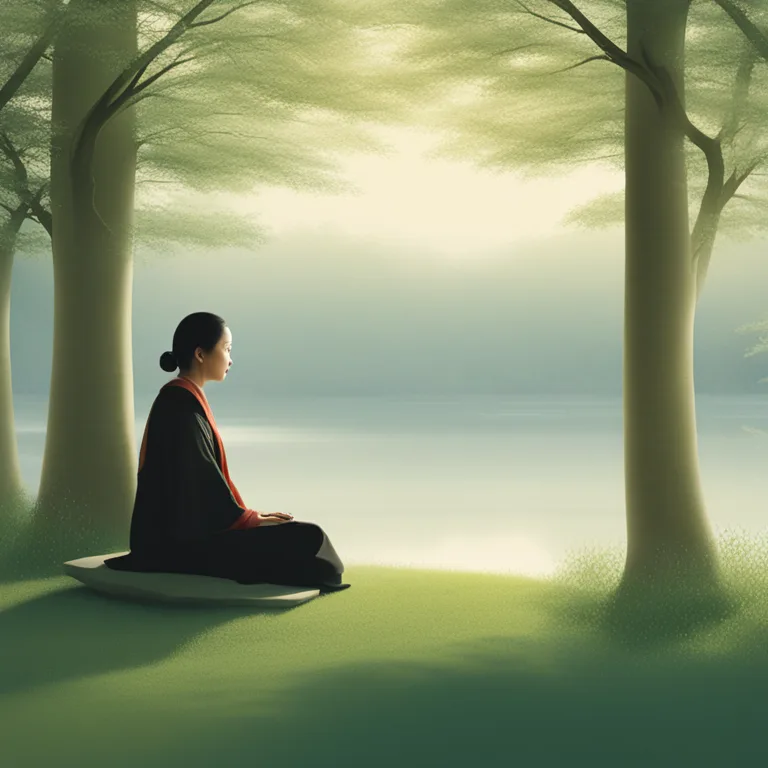
Koan Meditation Practices
Delve into the ancient practice of Koan meditation and discover techniques for inner peace and spiritual growth.
article by Hina Kurosawa
Koan Meditation Introduction
Koan meditation is a transformative practice deeply rooted in Zen Buddhism. This form of meditation utilizes paradoxical anecdotes or riddles that defy logical reasoning to promote enlightenment and the deepening of one's spiritual journey. In the Zen tradition, Koans are employed by masters to test a student's progress and to foster a direct experience of reality beyond words. As we approach meditation through Koans, we embark on a path that leads to profound self-realization and the dismantling of the conventional boundaries of thought.

Origins and Purpose
The origins of Koan meditation can be traced back to China during the Tang dynasty, eventually becoming a hallmark of Japanese Zen Buddhism. The primary purpose of engaging with a Koan is to transcend the dualistic way of thinking that dominates our everyday perception. By grappling with a Koan's seemingly inscrutable message, practitioners aim to reach a state of 'Satori,' or sudden enlightenment, where one experiences the true nature of existence and the interconnectedness of all things.

Choosing a Koan
The journey begins with the selection of a Koan. Traditionally, this would be assigned by a Zen master, but in modern practice, individuals may choose one that resonates with them. Some popular Koans include "What is the sound of one hand clapping?" or "What was your original face before your parents were born?" Picking a Koan is a personal process; it should be something that challenges your conceptual understanding and incites profound inquiry.

The Practice of Meditation
To engage in Koan meditation, the practitioner must find a quiet space and adopt a comfortable seated position, maintaining an erect posture. The Koan is then repeated mentally during meditation. Unlike other forms of meditation that encourage the clearing of the mind or focus on breath, Koan meditation invites an active yet non-judgemental pondering of the Koan. The aim is not to intellectualize a response but to open oneself up to the experience of not knowing, and in doing so, break through to the other side of awareness.

Common Challenges
Practitioners often face common challenges when working with Koans. It can be easy to get lost in rational thought or become frustrated with the lack of clear answers. The key to Koan meditation is persistence and patience. Embarking on this practice requires one to let go of the need for control or certainty and instead embrace the mystery and ambiguity inherent in the experience. Over time, the Koan seeps into the subconscious, allowing insights to arise naturally.
Integrating the Practice
Integration of the insights gained through Koan meditation into daily life is where the practice truly takes root. It's not just a seated exercise but a lens through which to view the world. As clarity and enlightenment emerge, practitioners may notice a shift in their reactions to life's challenges, fostering a more mindful and compassionate way of being. Life itself becomes the field of practice, every moment an opportunity to experience the lessons of the Koan.
Continuing the Journey
Koan meditation is not a one-time practice but a lifelong journey. Although it may seem demanding, the fruits of this practice are immeasurable. As you grow in your meditation and your understanding deepens, you may wish to seek out a Zen teacher or community to further your exploration. The beauty of Koan meditation lies in its boundless potential for growth and the endless unraveling of the deepest truths of our existence.
Published: 12/20/2023
Modified: 12/20/2023
More predictions
Come back here soon to learn more about yourself and your future


Sport life: Meditation Techniques for Athletes
Learn how meditation can enhance athletic performance, improve focus, and accelerate recovery. Discover key techniques tailored for the physical demands of athletes.


Calming The Mind With Meditation
Discover effective meditation techniques to ease your mind and promote serenity in your daily life.


The Best Meditation Techniques
Explore essential meditation practices to enhance your mental well-being and spiritual connection, suitable for beginners and seasoned practitioners.